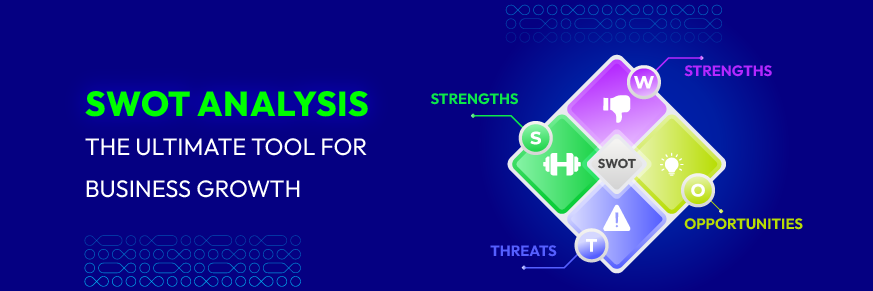How To Integrate Shopify With Quickbooks
Summer Nguyen | 06-19-2024
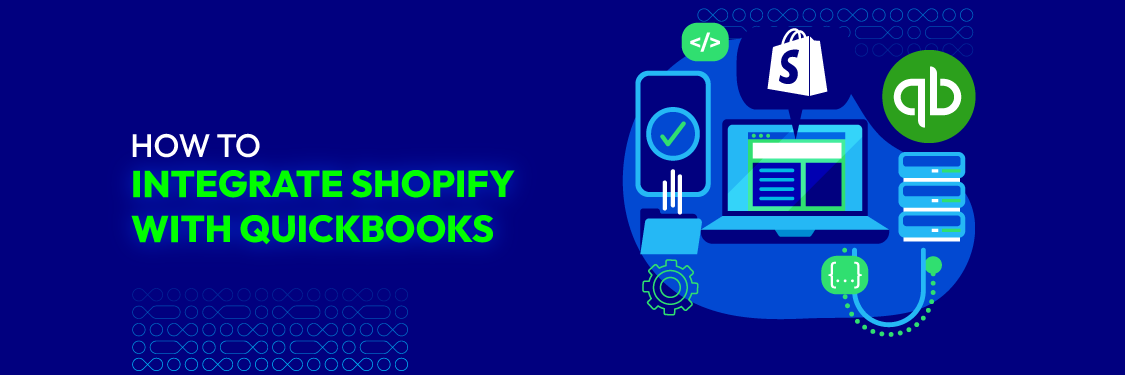
Running a business is not an easy game, especially if you’re a newcomer. There are multiple tasks that you have to handle, including accounting duties. Catering for all might be overwhelming, right? Here comes Quickbooks to rescue with financial management!
What is Quickbooks?

Quickbooks is an accounting program designed by Intuit to offer financing options to small and medium-sized enterprises. QuickBooks includes everything you need, from managing taxes to creating financial reports and keeping track of earnings and outlays. Depending on your needs, there are numerous more QuickBooks versions as well, however, Quickbooks Online is the most often used one.
Some of Quickbooks’ main features include:
- Invoicing: You can create customized invoices with your logo and brand design, then send them directly to customers through the software. It also allows you to monitor the status of customers’ payments and send liquidation notifications when needed.
- Expense tracking: You may easily keep track of your spending and expenses by connecting your credit card and bank accounts.
- Financial Reporting: Quickbooks generates comprehensive reports regarding your income, profitability, and expenses in addition to summarizing your financial data.
- Tax Management: Taxes issues might be cumbersome for newcomers on Shopify. Rest assured, Quickbooks will calculate all taxes and generate reports relating to tax filing and compliance for you.
Benefits of Shopify QuickBooks Integration
How can all these outstanding functionality assist your online business? There are 4 main significant advantages that the Quickbooks and Shopify Integration might bring you.
Time efficiency

The integration of Quickbooks with Shopify can significantly improve productivity by streamlining data processes between the two systems. If you still toss and turn about manual data entry and reconciliation issues, which can be laborious and error-prone, then now you can sit back and slowly solve your financial duties.
Cost saving
Although cost issues might be ambiguous when you first kick off your business, it would be best to focus on your cash flow management from the beginning. Quickbooks would be an indispensable tool for reducing accounting errors and enhancing your performance. You can avoid costly mistakes that might occur if you solve them all by yourself. This can greatly prevent incorrect financial statements and even penalties, which can cost tons of money. In addition, the reports would be a useful source of reference when you try to optimize business processes.
Enhanced inventory management
You can closely monitor the performance of your business through figures and statistics about your products. This helps you to track inventory levels in real time and better understand which products are selling well.
Up-to-date financial data
The data provided by Quickbooks are ensured to be accurate and up-to-date, allowing you to easily track and make informed decisions about your financial performance.
Security and data protection 
If you’re anxious that your financial data might be leaked somewhere else, that won’t ever happen with Quickbooks! Quickbooks employs backup systems and data centers to ensure that all users’ data is safe and secure within their control.
How to integrate Shopify with Quickbooks
Step 1: Kick off by navigating to the Shopify App Store. Here log in to your Shopify account.
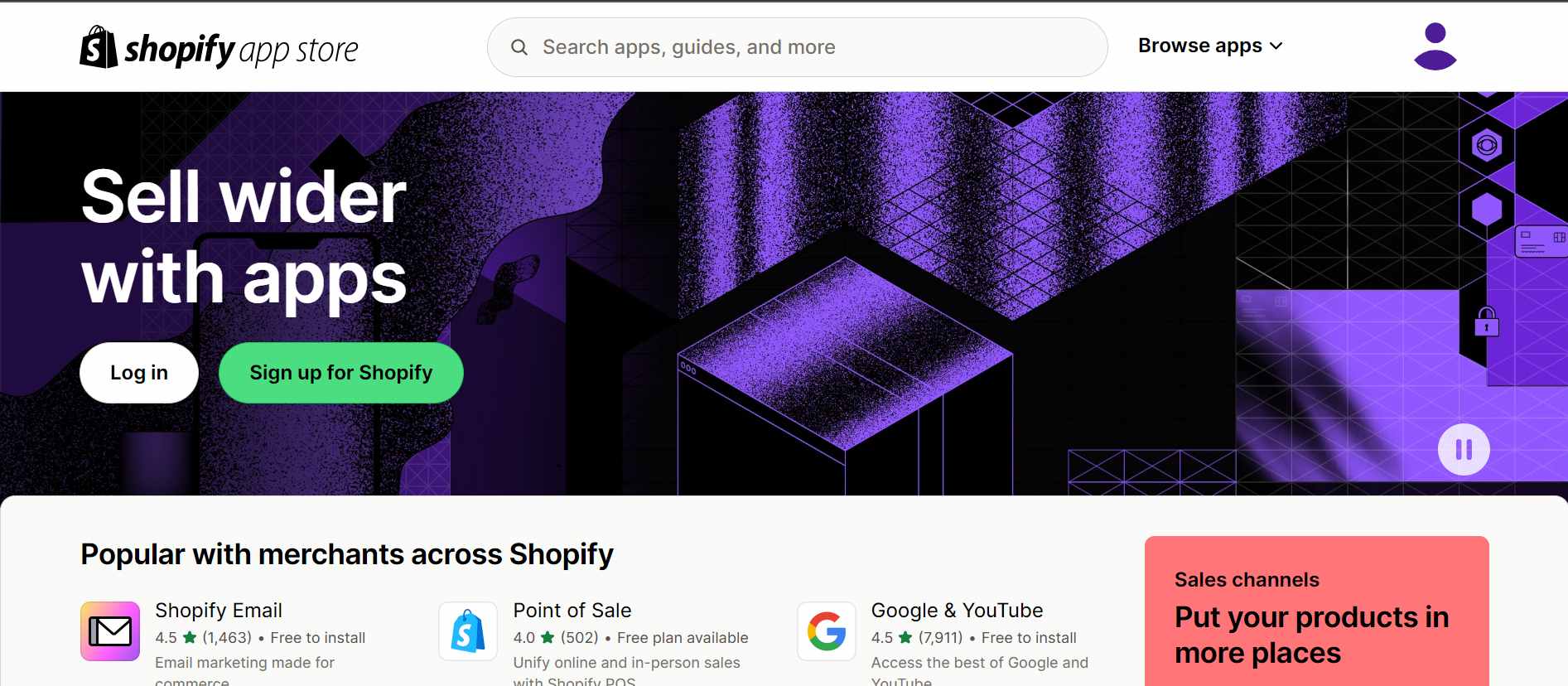
Step 2: On the search bar, enter the keyword “QuickBooks Online”. Don’t get too confused by the two options, you can click on any of them. However, we would suggest the QuickBooks Online Global with higher ratings, just for you to know.

Step 3: Click on the Install button to add the Quickbooks app.
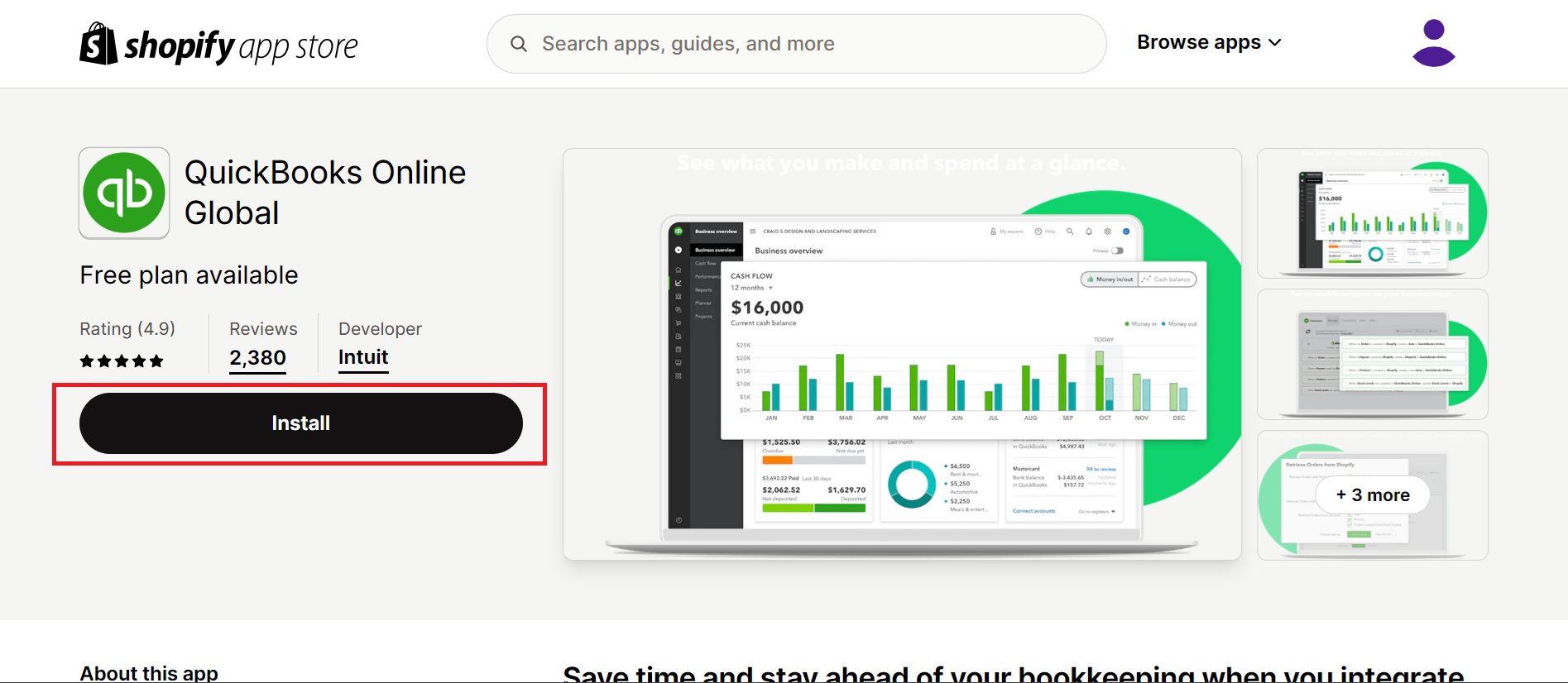
Step 4: You will then be taken to the page with the terms and privacy. Click Install to move on to the following steps if you accept the terms.

Step 5: In this stage, you’ll be required to authorize the app integration and log into your QuickBooks account. Select Connect to QuickBooks, then sign up for an Intuit account or create one.
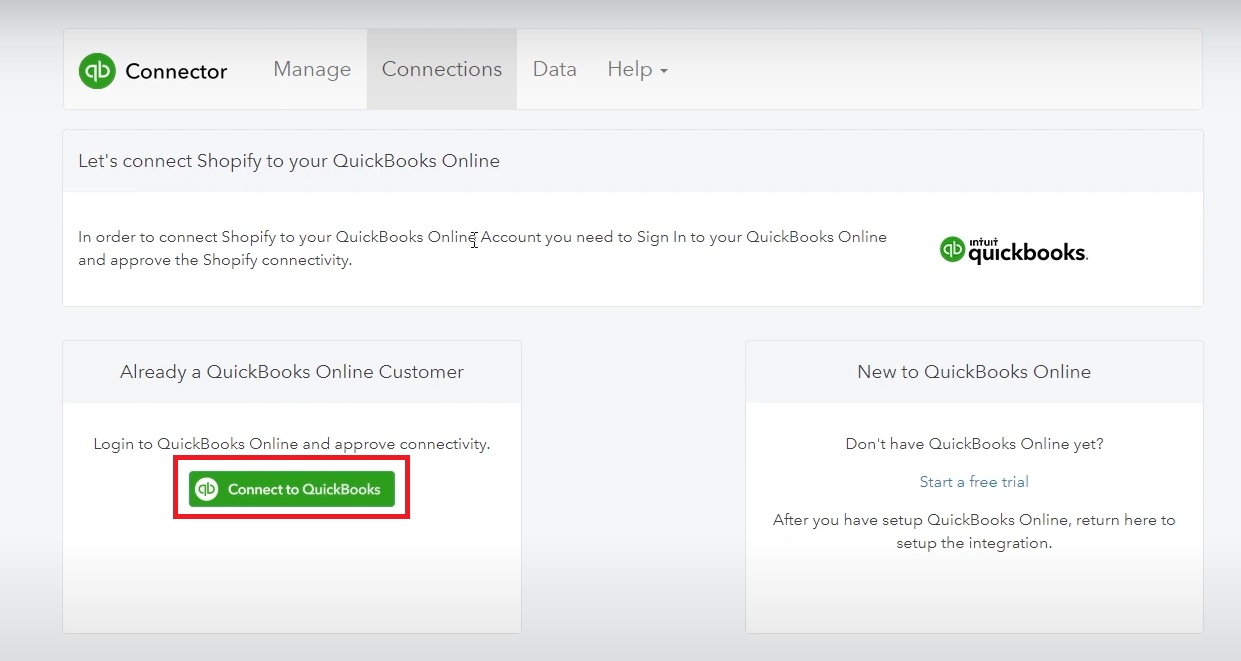
Step 6: Congratulations! You have just successfully integrated QuickBooks into your Shopify store.
Go to your Shopify admin dashboard, then choose Settings > Apps and sales channels. On this page, you will find the QuickBooks app that you have just added. You can click on the app to review its information.

3 Best Apps to Integrate Shopify with Quickbooks
#1 OneSaas by Quickbooks

OneSaas by Quickbooks is an integration platform that is also created by Intuit, playing a role as a bridge between your Shopify stores and QuickBooks. The technology of OneSaas will considerably deepen data integrations in QuickBooks Commerce and offer seamless integration.
Features
- Data syncing: OneSaas makes sure that all of your data such as sales, inventory, and customer data are automatically updated in both QuickBooks and Shopify. This will significantly minimize errors and remove the need for manual entry.
- Multi-channel Support: OneSaas helps connect several sales channels to QuickBooks, making sure that your inventory is always up-to-date.
- Tax Compliance: OneSaas can be a good option for foreign sellers since it offers automated tax calculations, allowing firms to maintain tax compliance.
Benefits
- Time-saving: By automating most of the process, OneSass saves you a significant amount of time to focus on other parts of your business.
- Error reduction: OneSaas ensures that your data is correct at all times and prevents all manual mistakes.
- Trustability: OneSaas was acquired by Intuit, making it a trustable tool to assist your Shopify and Quickbooks integration.
Limitations
- Third-party integrations: Unlike some other platforms, there are not many third-party partners available on OneSaas, making it difficult for you to extend your demands.
- Customer support: Supposing you meet an obstacle when using the platform, it might be strenuous to find help from professionals, as there are limited sources to contact.
- Price: The platform requires $69/month with Growth Businesses and $149/month with Scaling Businesses. This price might be expensive, especially for large businesses.
#2 Synder

Synder is a data integration tool that is dedicated to e-commerce businesses. Although only having been in the industry for 7 years, Synder has proved to be a reliable platform with significant success.
Features
- Data visualization: This might be beyond your expectations, but Synder even allows you to visualize your data aesthetically! There are many tools that can make your data more comprehensible such as dashboards and reports.
- Data transformation: Synder allows you to transform your data to meet your analysis demand; for example, filtering, enriching, and cleaning your data.
- Multi-platform support: Not only Shopify, Amazon, eBay, and BigCommerce are also available sale channels for your choice! In case you allocate your products to multiple platforms, this is definitely a perfect fit.
Benefits
- Customer support: When you have queries, don’t hesitate to reach out to Synder’s customer support. You can contact Synder through email, phone, live chat, or community forum.
- Ease of use: Synder has a user-friendly interface that makes it easy even if you are a new visitor. This is proved through the positive comments and testimonials from loyal customers.
- Comprehensive solution: The tool offers a lot of functionality with cutting-edge technology, so you can ensure that all of your demands are met.
Limitations
- Security issues: There might be potential problems relating to data security as Synder keeps user data on servers owned by third parties.
- Free-plan features: It is often recommended to purchase Synder’s premium plan because the free one doesn’t offer enough features. However, this may be troublesome for small businesses with low budgets.
- Finance management features: Compared to other competitors, the features Synder provides to manage and analyze your financial status are
#3 Zapier

Zapier is a popular web-based automation tool that allows you to connect Shopify and Quickbooks, as well as many other applications. Since its 2011 launch, the application has established a solid reputation among businesses and has been around for a while.
Features
- Multiple integrations: Zapier connects with several different applications in many categories. For example, if you want to expand your business on other e-commerce platforms, Zapier also integrates with BigCommerce, WooCommerce, Etsy, etc.
- Automated workflow: You can set up workflow on Zapier without any code needed.
- Customized workflows: Zapier uses actions and triggers to create processes that are tailored to your unique business requirements.
Benefits
- Enhanced data flow: There’s no need to manually transfer the data by yourself, resulting in quicker and more efficient progress.
- Improved customer experience: Zapier literally helps you cater to your customers from A to Z. After a successful sale is made, you can stay connected with customers through Zapier and turn them into loyal customers.
- Built-in templates: This may sound unfamiliar at first, but the templates on Zapier are very useful in making your experience less burdensome. Basically you can build everything as easy as a piece of cake by utilizing these templates.
Limitations
- Expensive premium plan: Paid plans support both single-step and multi-step workflows, with monthly starting prices of $19.99. There is also a free plan, but you are limited to single-step workflows and there are 100 tasks per month at max.
- Complexity: Unfortunately, Zapier is not something you can grasp overnight. Spending time understanding this software may take you several hours; however, the result is worth it.
Tips for Effective Shopify QuickBooks Integration

Tip #1 Define your goals
QuickBooks offers a lot of functions, so don’t let your excitement keep you away the most important thing: Can you make the most of all features? What are your expectations when integrating Shopify and QuickBooks? Is QuickBooks the most suitable software for your business? What are the pros and cons of this integration? Answer all these questions to make sure that the software is worth your time and effort.
Tip #2 Choose the right integration method
There are multiple factors to consider when choosing an integration app – you don’t want to change the platform in the middle way, right? Some crucial elements that you should consider include your budget, business demands, and security. Also, you can read reviews and ratings thoroughly to find the most suitable one.
Tip #3 Set up automated rules
You can consider automated rules as an instructor to guide your integration software to solve mundane and difficult tasks. These rules will help reduce potential errors, ensure your data is always up-to-date, and finally improve efficiency. Remember to test these rules after setting them to make sure they are working properly!
Tip #4 Monitor data accuracy
It is super important to monitor the accuracy of your data, as it has an impact on your financial reports, calculations, and performance. Besides reconciling data regularly, you can try setting up alerts for discrepancies and utilizing data validation tools.
Tip #5 Use reporting tools
Don’t look over tools that can help you maximize the value of your integration! These reporting tools play an important role in gaining invaluable insights, which help you make appropriate business decisions. Some popular reporting tools are Shopify Analytics, Quickbooks Online Reports, and Google Data Studio.
Wrap-up
We have gone through the features and benefits of QuickBooks, how to add QuickBooks into your Shopify as well as the best applications to assist your integration. QuickBooks is a strong tool to take advantage of your finance data and optimize your business. However, bear in mind that every app has limitations and QuickBooks is no exception. Therefore remember to review the pros and cons before installing. Hope that this will be helpful for your venture ahead!






